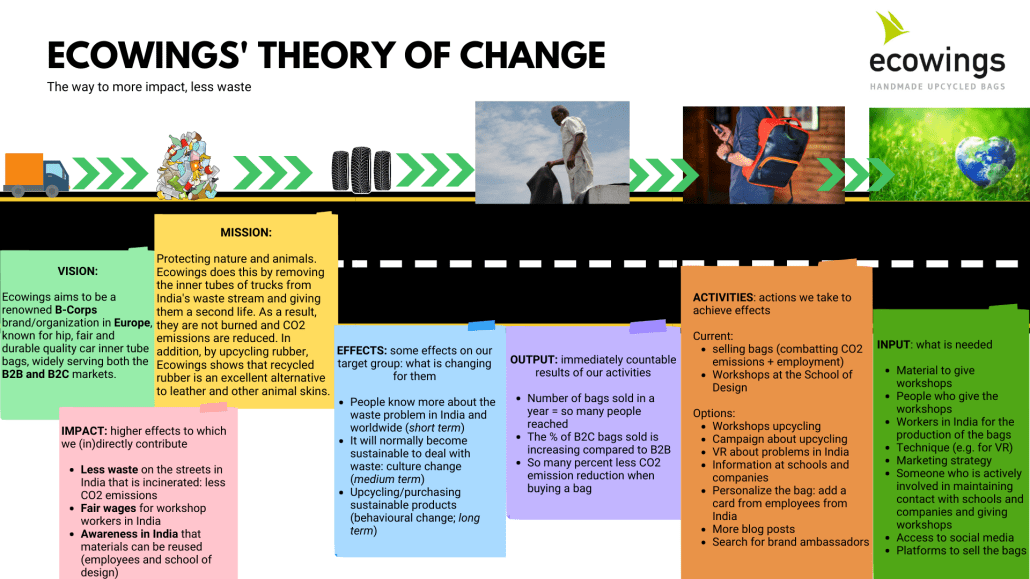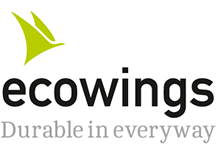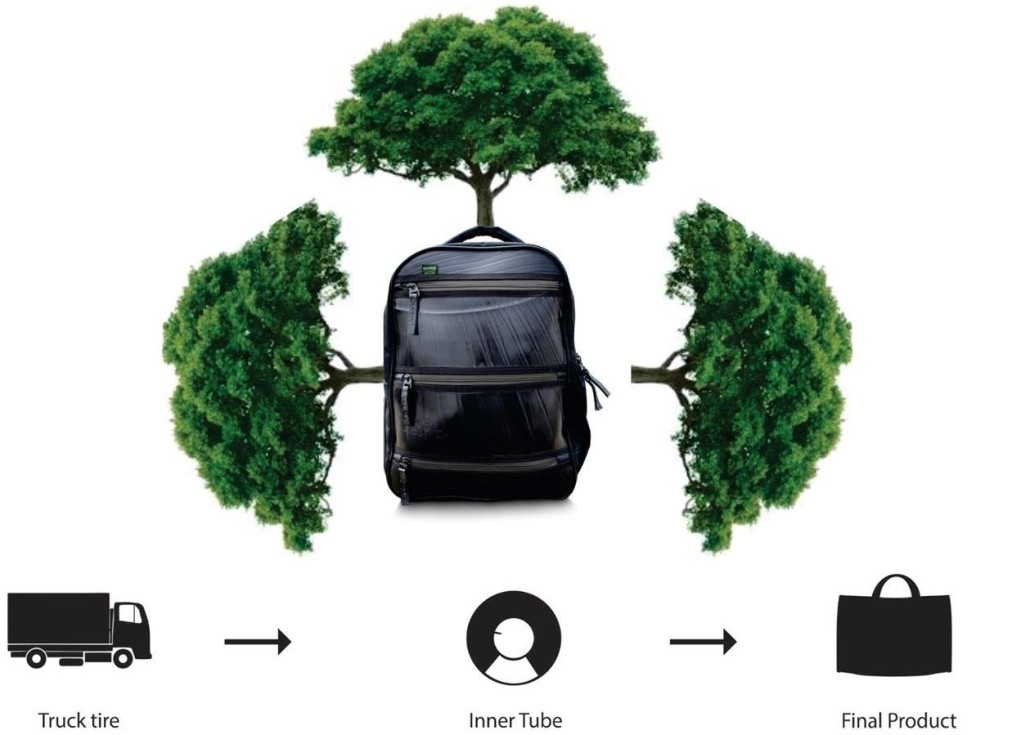From the organisation Futureproof 3 students did a research for Ecowings how to improve the marketing. Part of this was to draw a Theory of Change.
The theory of change explains how the company contributes to the image of the future world that they themselves have. It is important to map out the vision, impact, effects, output, activities and input. So on a conceptual level, the theory of change is about how your ‘intervention’ or product contributes to social change.
The vision is the starting point
In the vision, a company sets out what image it has for the future world. For Ecowings it can be said that the vision is based on a future world in which waste is dealt with responsibly, by reusing waste for new products.
Impact is about the effects that your activities achieve
This can be both intentional and unintentional and both negative and positive. It is important to be aware of this as a social enterprise, because impact can turn out differently than you had previously thought.
Ecowings makes an impact by selling bags. By selling bags Ecowings has an intended positive impact; every bag sold means that tires have been used for reuse instead of being incinerated. Burning 1 kg of rubber produces 1.8 kg of CO2 emissions. This saves 0.98 kg of CO2 emissions on average per bag.
An unintended negative effect of Ecowings as a company can be found in the transport aspect. The bags are made in India and often come to the Netherlands by ship or by plane. Due to the nature of the transport, such as polluting fuel, CO2 is still emitted. Ecowings is already aware of this. Partly because of this, Ecowings aims to sell more bags to consumers, so that air transport can be limited and more favourable transport by shipping can be used more often. When supplies are small, it is not profitable to ship the products. Due to larger deliveries, shipping can be used, which reduces CO2 emissions compared to transport by plane.
The effects
The effect within a theory of change is the change that results from the activities of the company. These changes can be divided into short-term, medium-term and long-term. It is important to be as concrete as possible and to limit the use of vague concepts by applying them as best as possible to the context. An effect is therefore the result of the company’s activities.
We have written the effects for Ecowings, whereby we have also made a distinction between short, medium and long term.
For the short term, we have formulated the following effects:
– Creating awareness that waste can be reused and processed into beautiful and high-quality products;
– Contributing to knowledge among people about the existence of the waste problem in the world in general and India specifically;
– The start of a contribution that people want to prevent their own waste from ending up on the street.
We have formulated the following effects for the medium term:
– Contributing to a culture change in which it becomes normal to deal with waste in a sustainable way;
– Contributing to awareness of the waste problem, both on a local and global level.
We have formulated the following effects for the long term:
– Contributing to a behavioural change in which it becomes normal to use upcycling techniques and the purchase of sustainable products;
– Contributing to a full awareness among consumers that waste can be reused and processed into beautiful and high-quality products.
The output is about the direct result of the activities
It is important that it is easy to measure and communicate. For Ecowings, this concerns the number of bags sold in a year and the extent to which sales among individual consumers have increased compared to the previous year. Another important output at Ecowings is the amount of CO2 emissions saved per bag sold. This is on average 0.98 kg of CO2 per bag.
The activities
The activities in a theory of change are the actions, tasks and things that the company undertakes to contribute to the result and the effects. This concerns activities that have a direct influence on the target group, with an educational and social character, rather than just services and products. For Ecowings, the most direct activity is selling bags. The sale of bags has two important aspects. On the one hand, CO2 emissions are prevented. On the other hand, Ecowings’ way of working ensures that people in the workplace in India receive a fair wage for the work they do.
While explaining the activities, we also brainstormed about activities that Ecowings can set up to increase awareness of the brand and thus also increase the impact. We thought of this:
– Upcycling workshops to introduce people to the use of ‘old’ materials for ‘new’ products;
– Campaign to use waste to create new products
– VR about issues in India;
– Education in schools to create awareness from an early age
– Get acquainted with Ecowings in a playful way;
– More blog posts on the website/social media and more active use of the newsletter, in order to increase awareness and involvement and to appear faster on google;
– Using ambassadors for the brand, in order to increase awareness.
The input is about what you need to be able to carry out your activities
The following factors are the most important input for Ecowings:
– Old inner tubes to make bags with
– Workers in India for the production of bags
– Marketing strategy
– Clear vision and mission
– Social media access
– Part of platforms to be able to sell bags
If the new activities are to be set up, more input is also needed. At this point you could think of:
– Material to give workshops (leftover material from the production of the bags is perhaps an idea);
– People who give the workshops;
– Technology (including for VR);
– Someone who is actively involved in maintaining contact with schools and companies and giving workshops.

Visual presentation
As a final step, a theory of change is often visualized in order to clarify everything that has been written above in one go and in an attractive way. We have also started working on this. We have devoted extensive attention to this, because we believe that a well-defined theory of change can be a good means of conveying the company’s story to the consumer. We were also told by Ecowings that they would like it if it was possible to use the theory of change themselves in their communication. We believe that our result has been successful and a clear overview of what we have described above. We therefore believe that Ecowings can make good use of the theory of change as we have formulated it.
Many thanks to Finn, Charlotte and Sanne for describing the Theory of Change and making this beautiful graphic!

